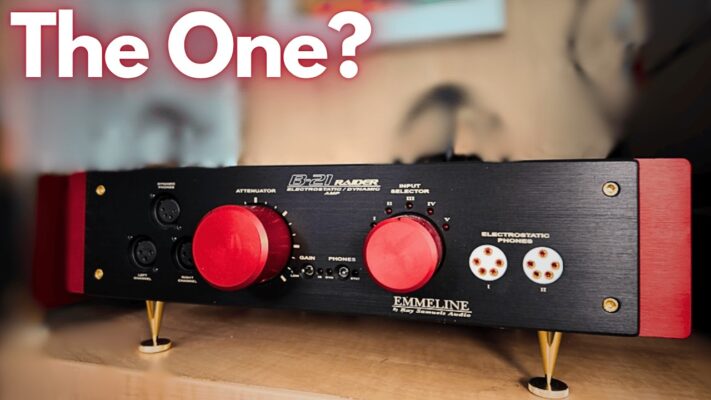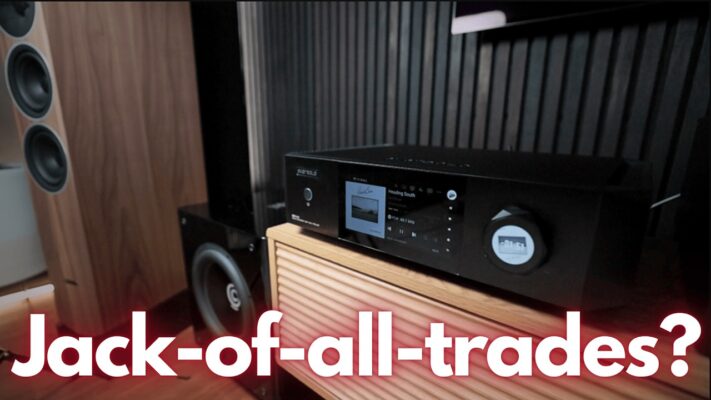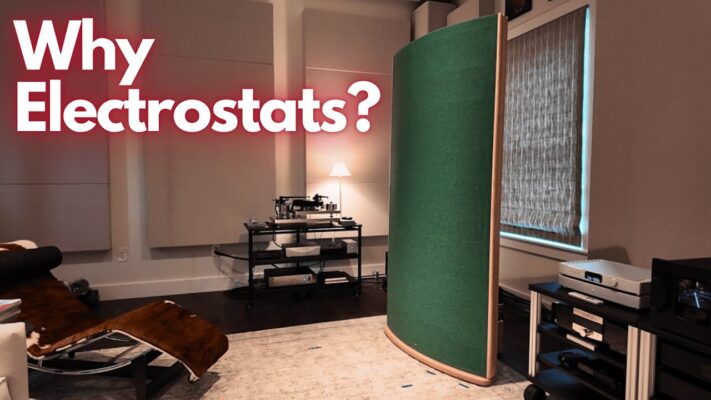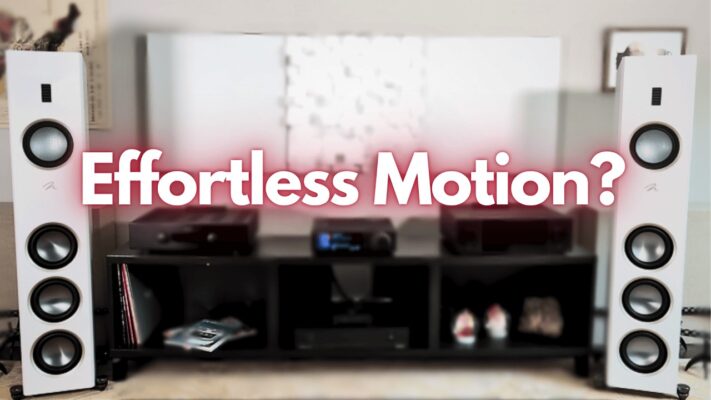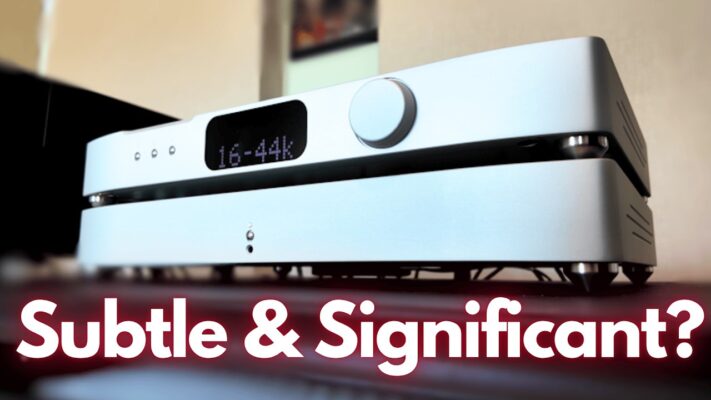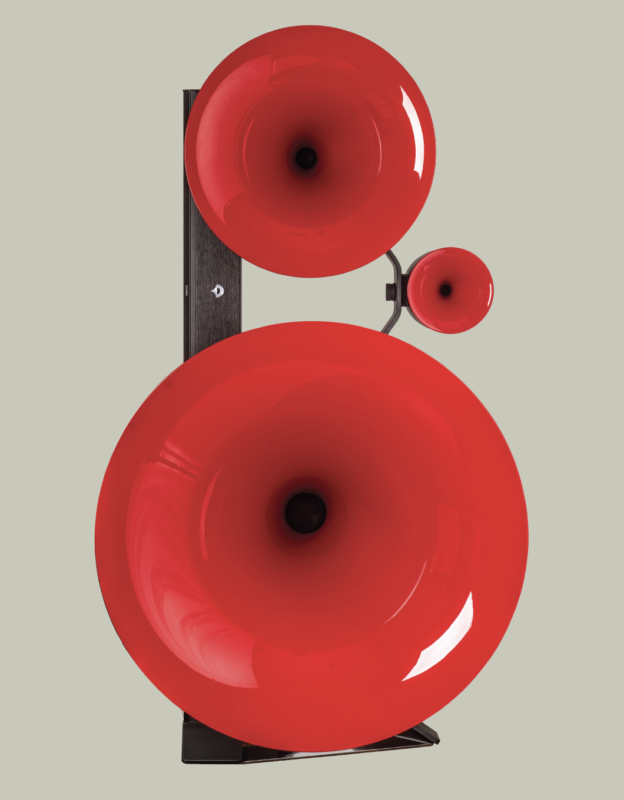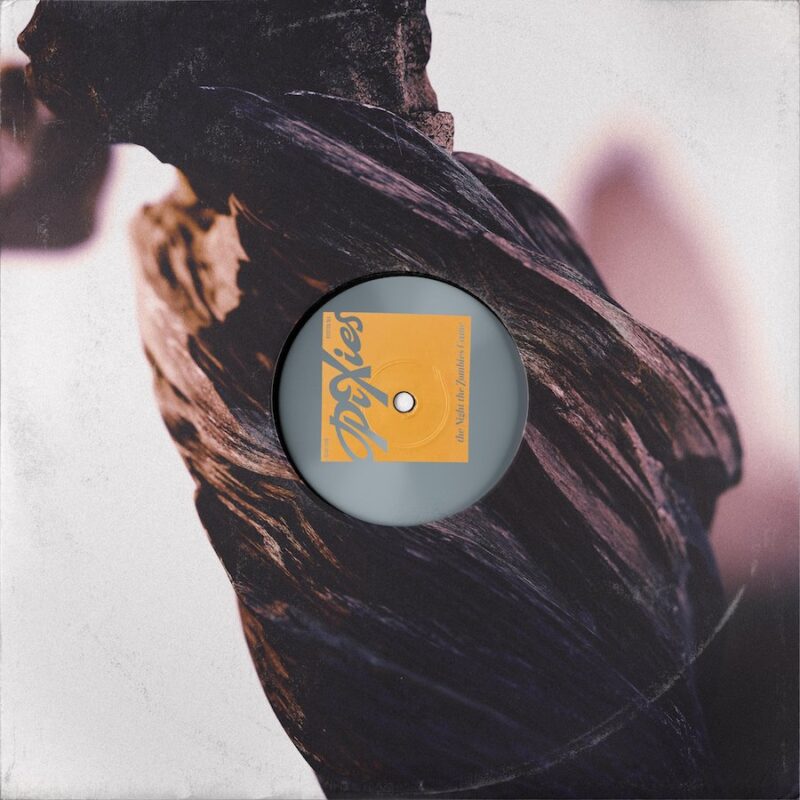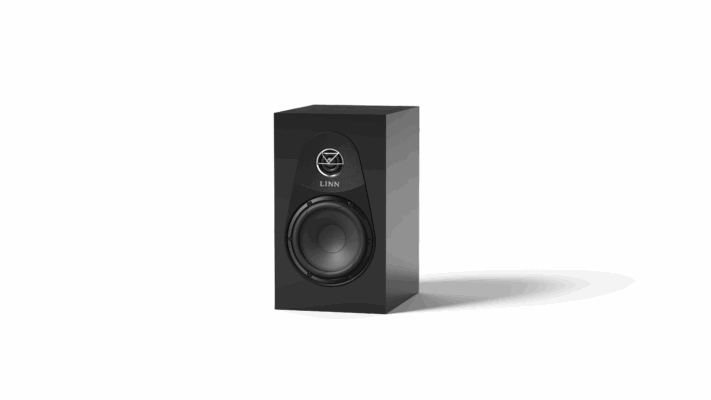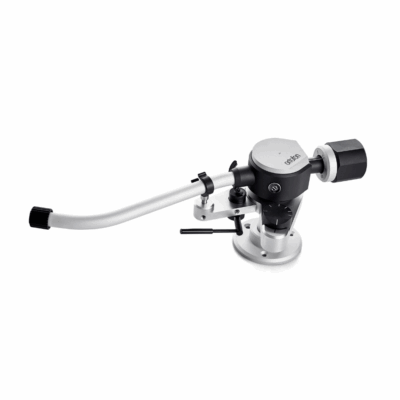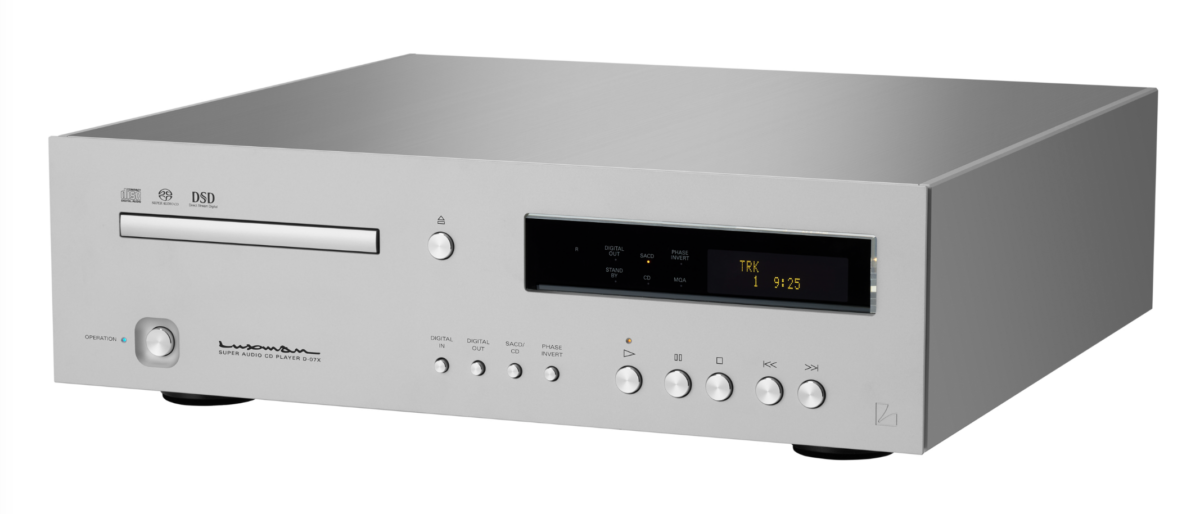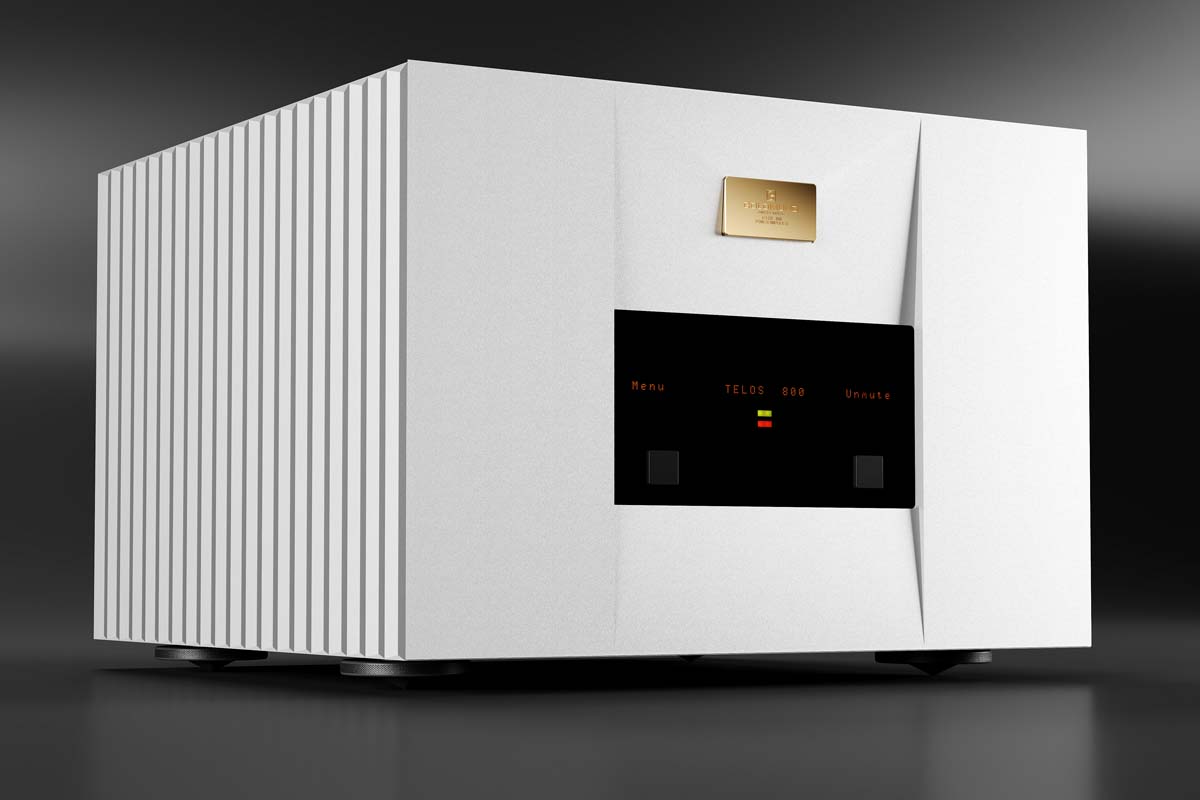
Goldmund’s new Telos 800 occupies a small and rarified niche in the audio market. It’s a stereo power amp that, at an eye-watering $89,000, costs as much as—more, really—than most high-end monoblock pairs would fetch. There are other members of this elite class from the likes of Soulution, MBL, and Constellation, and they all beg the same question: If you had that much to spend on amplification, wouldn’t you just go the monoblock route?
For me, the answer is not as obvious as it might seem. Like many readers, I have space and spouse-acceptance factors to consider. In that situation, having a single amplifier chassis that doesn’t take up floor space is a plus. And if that amp can rival—or even exceed—the power and sound of monoblocks, then the question becomes: “Why wouldn’t you go for the stereo amp?”
Which brings us to the Telos 800. Aesthetically, it’s an utterly striking work of industrial art that can take pride of place on a media console or equipment rack and immediately command the room. Sonically, the Goldmund amp sounds better in important ways than the vast majority of amps I’ve heard, monoblock or not. Indeed, the Telos 800 is far and away the best amp I’ve had in my system—and I’ve had some very good ones—and one of the finest amplifiers I’ve heard anywhere. What sets it apart? I’ll get to that. But first, there’s a story to tell about how Goldmund got here.
The New Goldmund
Goldmund has been one of high-end audio’s most esteemed and coveted brands since 1978, when it was founded and introduced its first product, the revolutionary (and revolutionarily expensive) Reference turntable. That product brought a new level of materials science and isolation techniques to turntable design, quickly establishing itself—and the brand—at the pinnacle of the high end.
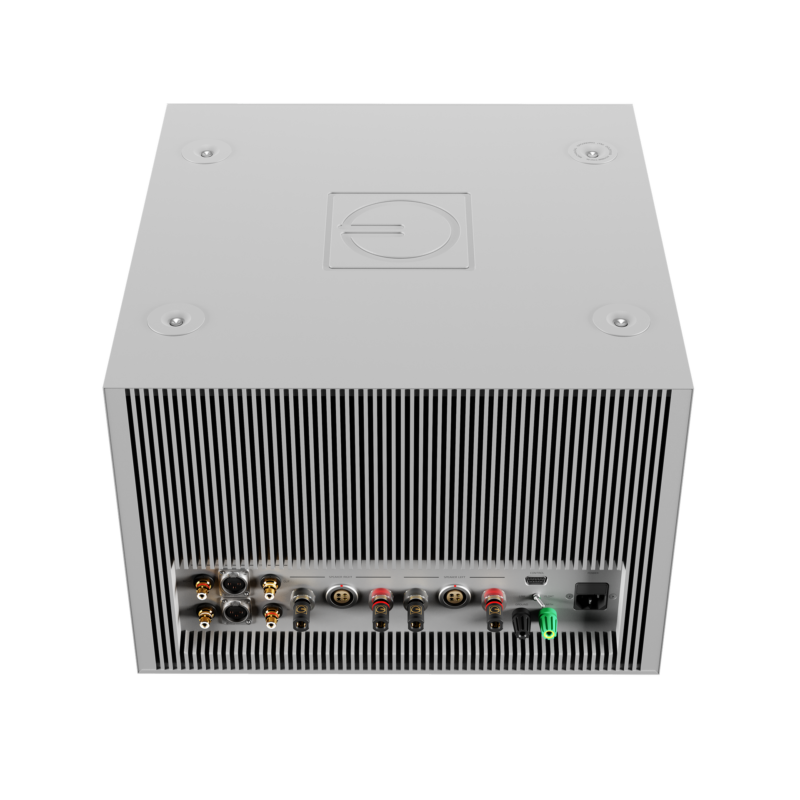
For decades thereafter, Goldmund went from success to success, expanding its product portfolio to well-received electronics, digital sources, cables, and speakers. Along the way, Goldmund pioneered many then-groundbreaking technologies, such as mechanical grounding and megahertz bandwidth (see “Telos Technology”), that are now considered table stakes at the top of today’s high end. The brand’s hallmark sound—speed, resolution, vanishingly low distortion, and previously unheard-of dynamics—could be found across the product range.
Unfortunately, the company’s decision in 1989 to purchase Stellavox, maker of bespoke open-reel tape decks, and subsequent poor management decisions eventually led to a cash crunch that derailed Goldmund’s momentum. Though it continued to introduce new products, for much of the early 21st century the company was without distribution in North America. As a result, today many younger audiophiles aren’t even aware of Goldmund or its influential past.
But all that is changing. Based on a visit to its sparkling new headquarters and factory, interviews with its technical and commercial leadership, and, most of all, its new products, I can confidently report that Goldmund has essentially been reborn.
First, there is new ownership in the person of Johan Segala, the stepson of Goldmund’s fabled founder, Michel Reverchon. Segala inherited the company and began a stint as CEO in 2018, when Monsieur Reverchon became too ill to continue running the firm. In addition to a cash infusion, Segala brought with him new leadership, culminating in 2023 when he lured Carsten Roth away from Focal/Naim to head up global sales.
A year later, Segala promoted Roth to CEO. Among the latter’s first acts was to bring in a new U.S. distributor, well-regarded Rhythm Distribution. Roth also moved the entire company, including the factory, to an all-new, fully modern facility on the outskirts of Geneva.
Yet some things remain the same. For instance, Goldmund’s vision has remained constant. Transparency remains the primary sonic goal, and to that end the company has updated the technologies it pioneered back in the 80s. Goldmund also continues to enhance the advanced metallurgy and materials science that elevated the original Reference turntable. Further, as in the past, Goldmund believes that there are advantages to keeping signals in the digital domain as far along the audio chain as possible. This explains the presence of digital inputs on all Telos amplifiers.
Another constant with the past is Goldmund’s propensity for frightfully expensive gear. The latest Gaia flagship powered speakers, for instance, cost a cool $710,000. And, as already noted, the Telos 800 under review runs $89,000. That price is even more remarkable considering that the 800 is the bottom of Goldmund’s amplifier line. The flagship Telos 8800 monoblocks, which put out 1400 watts, cost a princely $380,000 each.
However, now, as then, Goldmund delivers the goods. The first hint that Goldmund had once again hit its stride and was building world-class components was Jonathan Valin’s 2021 rave review of the NextGen 590 II integrated amplifier. Jonathan praised that unit, concluding that it “sets a new eye- and ear-opening standard for integrated amplifiers.” Now, with the Gaia powered speakers and revamped Telos amplifier range, Goldmund is intent on fielding more standard-setting products. The Telos 800 certainly qualifies.
Making a Vivid Impression
To evaluate the Telos 800, I compared it with recent exposures to live music, as well as to my reference CH Precision I1 integrated amp. Though the latter’s power amp section delivers fewer watts/channel than the Goldmund (100 vs. 300), until the Telos 800 I’d never had a better-sounding amp in my system, including some much more expensive stand-alone units.
Further, the CH Precision shares much of its technology and sonic performance with the Telos, which is not surprising since CH was partially founded and populated by Goldmund alums. As I’ve written before, the I1 is a miracle of dynamics, tonal color, resolution, and upgradeability. Plus, thanks to its pre-out ports, which bypass the internal amp in favor of an external unit, comparing the CH to the Telos 800 was a snap.
When I first made that switch, I was shocked. The sound was so much… larger. And by that I meant bigger in scale and possessing more sheer musical and sonic information. But I soon realized that “larger” was an insufficient descriptor for the wholesale change I was hearing. I needed a better word to describe the sound. Ultimately, I decided the sound was much more…vivid.
What does that mean? Perhaps the best way to explain is by analogy. Go to your nearest Best Buy and check out the wall of TVs. They all look sharper—with more vibrant colors and greater depth—than usual. That’s because their pictures are literally set to Vivid for demonstration purposes. Unfortunately, there is a price to be paid when a TV is so configured. Colors are indeed saturated, but to an unnatural degree. And there is such a thing as being too sharp, which lends an electronic edge to images.
But imagine if, in the audio world, you could have all the benefits of a Vivid setting but without the downsides. Indeed, what if you could have a vivid recreation of sound where everything was more rather than less realistic. That’s what the Telos 800 does.
There are many factors that contribute to this phenomenon. I’ve already mentioned two of them: presentation scale and density of musical and sonic information. But that’s just the beginning. There’s also the fact that within the vast scale the Telos creates, instruments are so precisely positioned and so stable you can sit farther off-axis and still preserve the stereo image.
And part of the 800’s sonic information density is a wealth of timbral colors that makes instruments sound distinctly more like themselves. You can hear this 30 seconds into the 30th Anniversary edition of Jazz at the Pawnshop. What were unremarkable drums, for example, become full-fledged simulacrums through the Goldmund.
But many top amps do these things to one degree or another. So, while these virtues contribute to the Goldmund’s excellence, they don’t fully explain how and why it sounds so much different—and better—than most of those other amps. For that explanation, we must turn to two far less common attributes.
Heads and Tails
Reviewers often listen to how notes trail off—their “tails.” A long, gradual diminishment is a sign of excellent low-level resolution, whereas a curtailed drop-off signals the opposite. To be sure, the Telos 800 offers long tails. Just listen, for instance, to the electronic accents at the beginning of London Grammar’s “Hey Now.” Through the Goldmund, their tails stretch on and on.
But the “heads” of notes and transients—how they begin—are equally important. Ideally, there should be no lag, blur or fade-in as the note starts up. Instead, it should go from rest to full power instantaneously. Most amps can’t and don’t do this; there is either an ill-defined start or a subtle glide into the note or transient attack. Like so many distortions, this one isn’t particularly noticeable until it’s gone. The Goldmund, with its high-bandwidth and thus high-speed circuitry, banishes this artifact. That turns out to have a surprisingly significant effect on the level of realism it delivers.
As it happens, I recently attended a day-long “Blues and Brews” festival, featuring three local blues bands. There I noticed, as I have in the past, that real drums are particularly easy to identify as live rather than recorded. One reason is the unrestrained dynamics of real drums. But this time I also noticed that a live drum whack starts without any “build up.” Instead, it just starts, coming out of nowhere. This, I realized, is exactly what the Goldmund amp was doing at home, and it helped explain why the amp sounds so lifelike.
Now, my CH I1 happens to be extremely good at transients. But compared to the Goldmund, it’s like a sports car with an internal combustion engine: despite lots of horsepower and torque, there’s still a slight but unavoidable lag before it reaches full power. In contrast, the Goldmund amp is like an EV: full torque is available instantaneously at any speed with no lag. And just like with EVs, once you’ve experienced that instant acceleration, it’s hard to go back. Another analogy would employ cone versus planar drivers. With respect to how it handles the starts of notes and transients, the Telos 800 is the amplifier equivalent of a planar speaker.
This gives the music a startling immediacy, and I experienced it on pretty much everything; though, as you might expect, bass and drums were the biggest beneficiaries. Take the Notting Hillbillies’ beautifully recorded “Your Own Sweet Way.” On the CH Precision, bass notes are full, but they have no leading edge to speak of. Not so with the Telos, which delivers tight, crisp leading edges. Likewise, the Sonny Rollins track “I’m an Old Cowhand” from Way Out West has a fast-moving bass line which, through the Goldmund, is clearer and much easier to hear. Moreover, drums and bass instruments sound far more realistic through the Telos, and I suspect a lot of that has to do with its proficiency with heads and tails.
Dynamic Envelope
Another uncommon factor that sets the Telos 800 apart is what I’m calling its “dynamic envelope.” This is akin to dynamic range, but I prefer the term envelope because a range is fixed whereas an envelope can be “pushed” or “stretched.” The Telos 800 stretches the music’s dynamic envelope.
Again, what do I mean by that? Well, I never thought of other great amps as pulling their punches, dynamically speaking. But compared to the Goldmund, they do. To employ another car analogy, when music asks an amp to deliver a dynamic peak, most amps will go from 0–60 mph without a sweat. Better amps will top out at 80 mph. But the Goldmund goes all the way from 0–100 mph, thus delivering the full measure of intended drama. Through the Telos 800, instruments don’t just get louder, they veritably pop out of the speakers.
This was apparent, for instance, on the wonderful head-banger “Los” by the German band Rammstein. (Go ahead, stream it loudly!) The opening is an aggressively played acoustic guitar. On a good system, there is significant emphasis on the downbeats. Through the Goldmund those dynamic bursts are more apparent and forceful, because the amp is expanding the dynamic envelope.
Another (probably better) illustrator of this phenomenon is the Third Movement of Mahler’s Second Symphony. The entire movement is built around the theme of dynamic contrasts. If those contrasts aren’t sufficiently stark, you’re missing out on what Mahler intended—or what you’d hear in a live concert. Through the Telos 800, the Vienna Philharmonic under Gilbert Kaplan (DG) delivers playful sparks of sound and dynamic exclamation marks that really jump out at you. And when the full orchestra comes in, dark and unrestrained near the movement’s end, the effect is terrifying. That’s a vivid presentation, to be sure.
Of course, dynamic changes don’t have to be sudden. Lots of music features gradual buildups (or decreases). You want crescendos to reach their full and true peak, not some curtailed version of it. The Telos 800 does this in spades. A good example is Fleetwood Mac’s “Over and Over.” After a 3½ minutes with steady dynamics, the song unexpectedly heads into a slow crescendo. Through the Goldmund, the build-up of tension becomes all but unbearable—until it’s finally shattered by one of Mick Fleetwood’s rare cymbal crashes. Again, the expanded dynamic envelope helps create a vivid musical experience.
I know what you’re thinking: This is all because the Telos 800 is more powerful than my reference amp. Well, not so fast. I’ve had powerful amps in my system, and while they did enable greater overall volume and stronger bass, they did not stretch the dynamic envelope like the Goldmund does. And, unlike the Telos 800, not one of them was any more vivid than my I1.
Conclusion: Undiminished Returns
Several years ago, upon hearing the then-new Magico M9 speakers, Robert Harley bravely declared that the law of diminishing returns did not apply to high-end audio. With truly exceptional products, he professed, very expensive gear can be proportionately (as opposed to fractionally) better than less expensive options.
I absorbed this rather radical stance with extreme skepticism. I had always found that the law of diminishing returns applied as much to high-end audio as it did to everything else. But, as the Monkees once sang, “Now I’m a believer.”
It’s true that the Goldmund Telos 800 costs a staggering $89,000. But to my surprise, I find that it’s worth every penny. This amp is no mere incremental improvement over less expensive—though still costly—amplifiers. To my ears it represents a sea change in sonic capability, delivering a presentation that makes music more engrossing, enlightening, realistic and awe-inspiring, not to mention fun. Is it worth three times as much as my excellent reference amp? Absolutely. If I could afford it, I would. As it stands, I’m not sure how I’m going to live without it.
On a higher level, the Telos 800 is indicative of what the new Goldmund is capable of, and a promising harbinger of what’s to come. For now, a once-great company is great once again.
Specs & Pricing
Balanced inputs: 1
Unbalanced inputs: 1
Digital inputs: 1
Output power (stereo 8 Ω): 300Wpc
Frequency response: 0 Hz–over 1MHz (+0 dB/–.5 dB)
Dynamic range: 110dB
THD + noise (@1W): <0.05%
Damping factor: 600
Shipping weight: 57 kg
Dimensions: 17.3″ x 13″ x 17.8″
Price: $89,000
Associated Equipment
Analog source: Lyra Etna Lambda Edition cartridge, Goldmund Studietto turntable, Graham 2.2 tonearm
Digital source: Bryston BCD-3 CD player
Electronics: CH Precision I1 integrated amplifier (phonostage, DAC, streamer, linestage, power amplifier)
Speaker: Wilson Audio Sasha V
Cables and cords: Empirical Design
Footers: Goldmund Cones
Tags: POWER AMPLIFIER GOLDMUND REVIEW

By Alan Taffel
I can thank my parents for introducing me to both good music and good sound at an early age. Their extensive classical music collection, played through an enviable system, continually filled our house. When I was two, my parents gave me one of those all-in-one changers, which I played to death.
More articles from this editor









